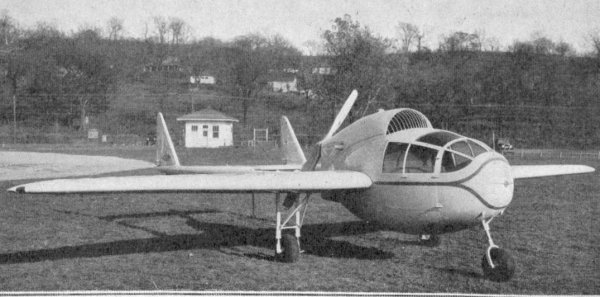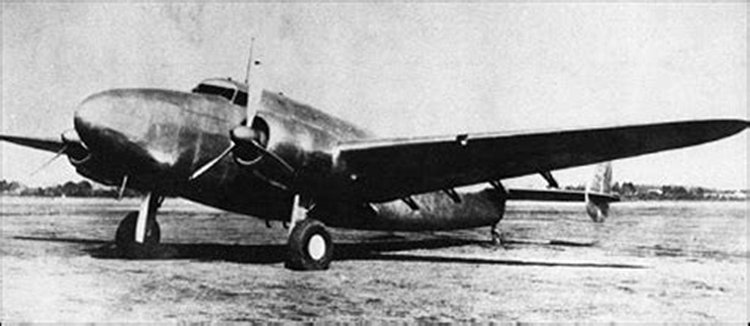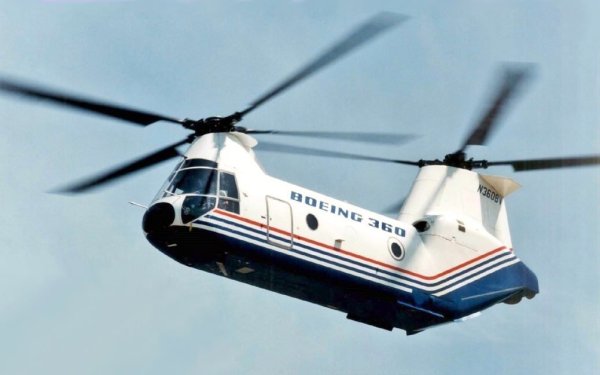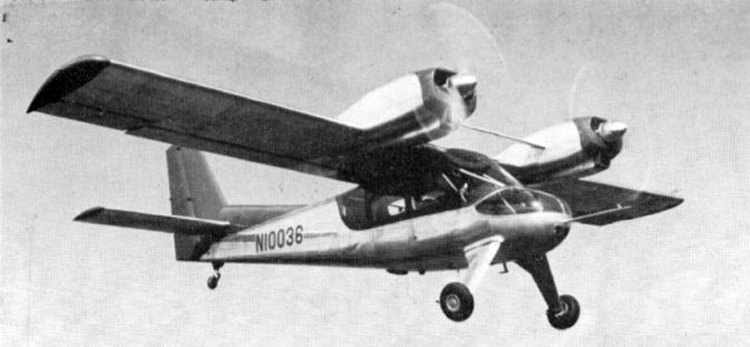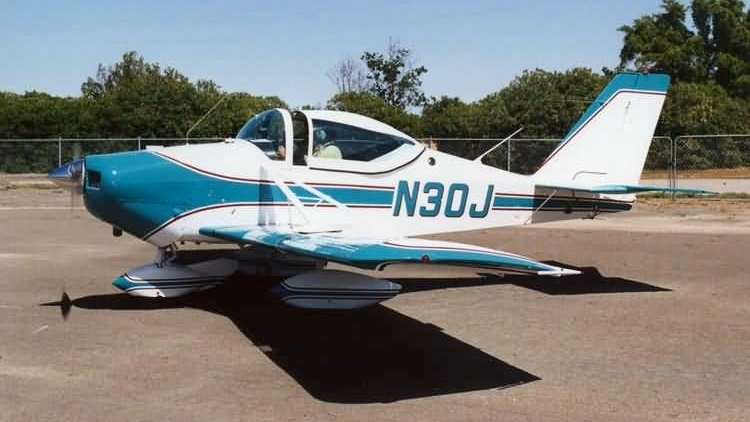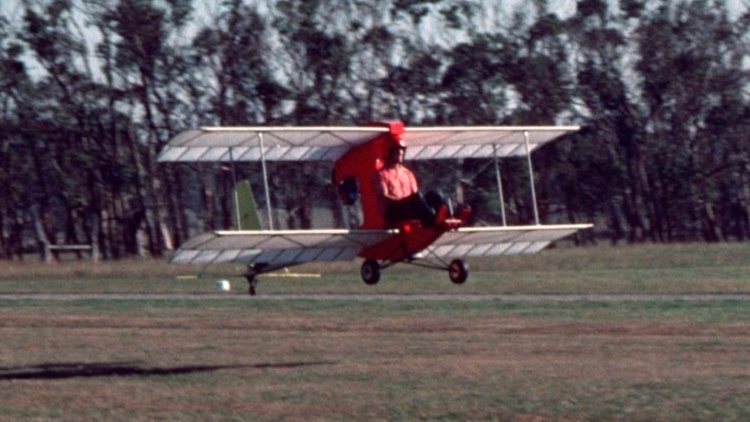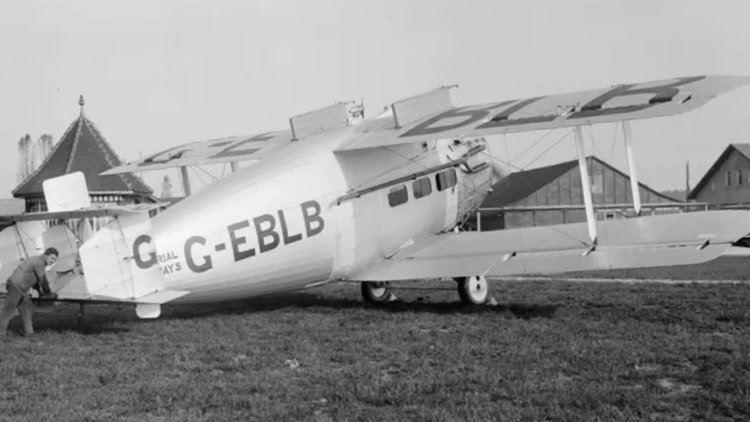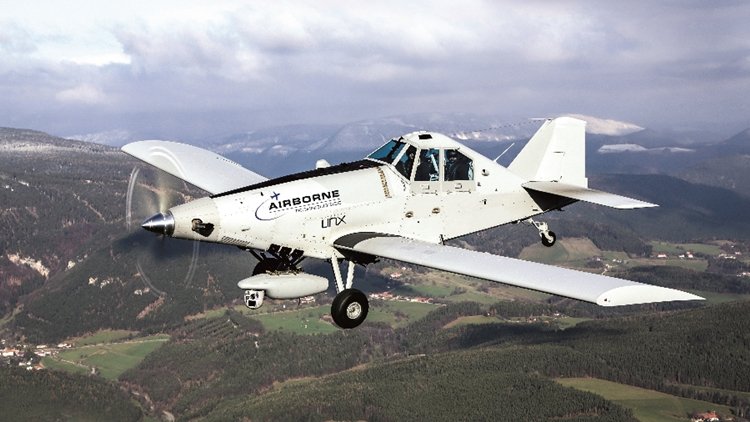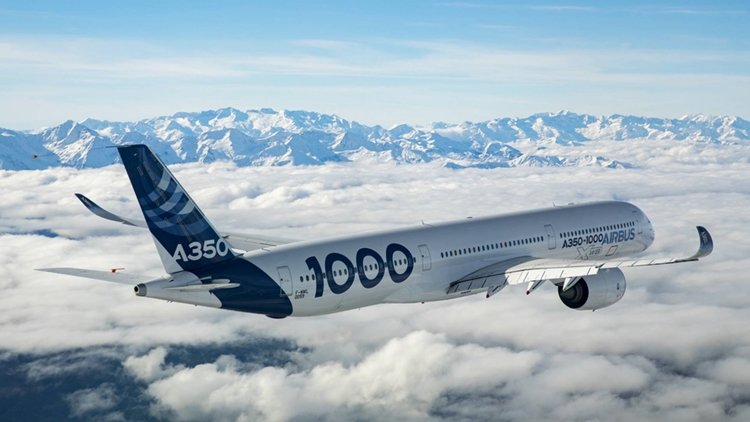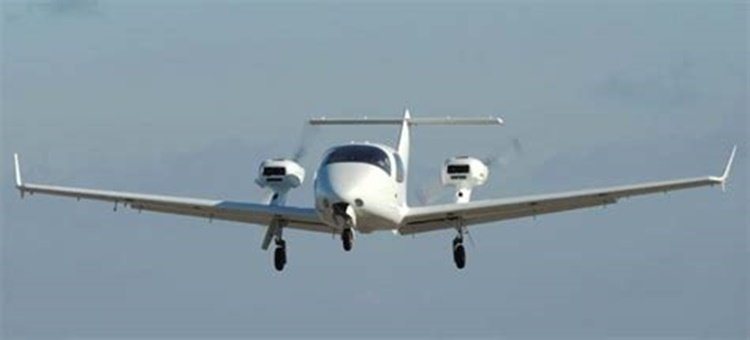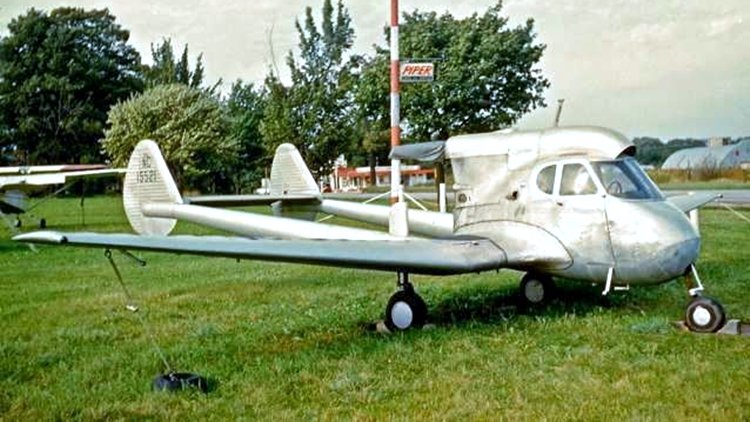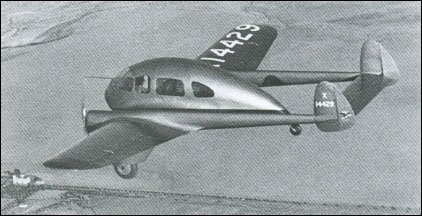-
Posts
7,574 -
Joined
-
Last visited
-
Days Won
67
Content Type
Profiles
Forums
Gallery
Downloads
Blogs
Events
Store
Aircraft
Resources
Tutorials
Articles
Classifieds
Movies
Books
Community Map
Quizzes
Videos Directory
Everything posted by red750
-
Searched high and low for weights, stall speed, RoC, couldn't find anything.
-

Wing Aviation Pty Ltd drones - coming soon to Melbourne
red750 replied to SGM's topic in AUS/NZ General Discussion
Their advertising blurb is that at 100 kph, your pizza and coffee arrives hot. -
The Campbell Model F, a pusher configuration, two seat sport aircraft built in the 1930s, was unconventional in its day with its empennage on twin, slim booms, a cockpit under stepless, rounded, multi-panel glazing and a tricycle undercarriage. The Model F first flew in 1935, though the exact date is unknown. By 1937, if not earlier, it was making demonstration flights including one from Bolling Air Force Base. It was damaged in another demonstration and was not repaired. For details of development and design, click here.
-
The Kawasaki Ki-56 (Japanese: 一式貨物輸送機, Type 1 Freight Transport) was a Japanese two-engine light transport aircraft used during World War II. It was known to the Allies by the reporting name "Thalia". 121 were built between 1940 and 1943. The Kawasaki Ki-56 was derived from the Lockheed Model 14 Super Electra aircraft that the Kawasaki Kokuki Kogyo Kabushiki Kaisha (The Kawasaki Aircraft Engineering Company Limited) had built under licence. In September 1939 Kawasaki was asked by the Koku Hombu to design an improved version as Ki-56. A number was also built by Tachikawa Hikoki K.K. The Japanese invasion of Sumatra in the Dutch East Indies campaign began with a paratroop drop from Ki-56 transports on Airfield P1 and the oil refineries near Palembang. Royal Air Force Hawker Hurricane fighters flying from P1 to locate the Japanese invasion fleet passed the incoming Ki-56s, but thought them to be friendly Lockheed Hudsons (also developed from the Lockheed Model 14) returning from a raid. The defending anti-aircraft gunners at P1 were equally fooled, until the parachutes began to open. Once the AA guns opened fire one transport was shot down, another force-landed, and others veered off course, but the paratroop drop was effective and the airfield and oil installations were overrun.
-
The Emigh A-2 Trojan was an American single-engined cabin cantilever monoplane designed and built by the Emigh Trojan Aircraft Company of Douglas, Arizona. The A-2 had side-by-side seating in an enclosed cabin for a pilot and passenger. Of all metal construction it had a fixed tricycle landing gear and was powered by a Continental A90 flat-four piston engine. Many major components of the aircraft were designed to be interchangeable to simplify and lower manufacturing costs. The vertical and horizontal stabilizers where interchange able as well as the rudder and elevators. A symmetrical section of the wing was interchangeable and the upper and lower fuselage skins were also identical. A total of 58 Trojans had been completed when production ceased in 1950.
-
The Boeing Model 360 is an American experimental medium-lift tandem rotor cargo helicopter developed privately by Boeing to demonstrate advanced helicopter technology. The aircraft was intended as a technology demonstrator, with no plans to put the type into production, and many of its design features were carried onto other programs including the RAH-66 Comanche and V-22 Osprey. The sole prototype has been preserved and is a static exhibit at the American Helicopter Museum in West Chester, Pennsylvania.
-
The Helio Twin Courier is a twin-engined version of the Helio Courier, with only seven examples being produced. Known by Helio as the model H-500 this STOL aircraft mounted twin Lycoming engines on top of the high-set wing, close to the fuselage. With the engines mounted in this manner, lateral and over-the-nose visibility were much improved while the propellers were kept clear of cabin doors and away from possible debris damage during rough field operations. This was a tail-wheel design, so the vertical component of propeller thrust assisted STOL take-off performance from rough fields. In 1967 or 68, work was started on a redesign of the Twin Courier in a tricycle-gear configuration for the commercial market, since many firms which desired STOL capability had regulations which required multi-engine aircraft. The company ran out of money and the project was terminated. The aircraft structure of the Helio Stallion, a single-engine turboprop version of the more successful Helio Courier, was based on the design of the Twin Courier. The Twin Courier could seat six and first flew in April 1960, being awarded FAA certification on June 11, 1963. (The Twin Courier met FAA requirements marginally and was certificated to meet immediate needs for service in Vietnam, on the understanding that the design would not be marketed commercially. Thus, the redesign mentioned above.) Only seven examples were built, these receiving the United States Armed Forces designation U-5A. One was reported to have been evaluated by US Army Special Forces. Furthermore, fully automatic full-span, leading-edge slats were fitted along with high-lift flaps.
-
The Stits SA-11A Playmate is a homebuilt aircraft design that features a rapid wing-folding mechanism for trailering or storage. The SA-11A is a single engine, side-by-side configuration seating, tricycle gear, strut-braced, low wing monoplane. The fuselage is welded steel tubing with aircraft fabric covering. The wings have a quick release mechanism that allows them to fold and lock alongside the fuselage in 15–30 seconds. Safety mechanisms were put in place so pilots could visually inspect that the wings were locked in place. A small sideways seat in the rear can accommodate 150 lb (68 kg) of luggage or a light passenger. The prototype was donated by Ray Stits in 1969 to the EAA AirVenture Museum in Oshkosh, Wisconsin. Its engine went into the Stits SA-9A "Skycoupe" prototype for testing and development.
-
The Hovey Whing Ding is an extremely minimalist American ultralight aircraft that was designed by Bob Hovey of Saugus, California, first flying in 1971. The aircraft is supplied in the form of plans for amateur construction by the Vintage Ultralight and Lightplane Association of Marietta, Georgia. Hovey set out to create the lightest aircraft to carry a person ever to fly, with the resulting design being a biplane, with a plywood box filled with Polyurethane foam serving as the fuselage, supporting the pilot's seat. The aircraft features a conventional fabric-covered empennage carried at the end of a short tailboom made of aluminum tube. The horizontal stabilizer is made from reinforced cardboard. Early versions used wing warping for roll control, while later models used full-span ailerons. The specified pusher configuration powerplant is a McCulloch chainsaw engine turning a hand-carved wooden propeller via a chain drive. The first prototype had a monowheel undercarriage, with skids under the wingtips, but this was soon changed to twin mainwheels carried on a spring-type strut. With no brakes to stop the aircraft after landing, pilots were supposed to press their heels against the mainwheels. The Whing Ding was designed long before the US FAR 103 Ultralight Vehicles regulations were introduced, but it fully conforms to the rules. The Whing Ding helped generate interest in ultralight aircraft and lead to the ultralight boom of the late 1970s and 1980s. Hovey conceived of the aircraft as an experimental project and not as a form of transportation. Due to its unreliable powerplant he intended it to only be flown over open areas where a safe landing could be carried out at any time. The plans were complex to follow and were not intended to make construction easy. Construction time typically is about 400 hours. The Whing Ding was marketed as plans, and sold extremely well - by 1979, over 6,000 sets had been purchased. In 2011 the plans were still available, and at no cost. Depending on the density altitude and the weight of the pilot, some builders discovered that the aircraft was under powered and suffered from too small a wing area to climb out of ground effect. Variants Whing Ding Initial version Whing Ding II Improved version, incorporating a higher seat to prevent pilots dragging their feet on the ground to stop the aircraft, which resulting in broken bones in some cases.
-
S.O.30 Nene test bed with Rolls Royce Nenes. Two prototypes modified.
-
The Ayres LM200 Loadmaster was a small cargo aircraft developed in the 1990s by Ayres Corporation largely for the needs of small-package carriers. In 1996, urged on by Federal Express, development was begun, designed to carry four demi containers. The aircraft was to be powered by a LHTEC CTP800-4T turboprop, which was composed of two CTP800s driving a single five-bladed Hamilton-Standard propeller through a combining gearbox. To support this development effort, Ayres acquired the LET aircraft manufacturing company in the Czech Republic in September 1998. In 2001, the company was forced into bankruptcy when creditors foreclosed on it, and the Loadmaster program was terminated.
-
On 10 July, an American Airlines Boeing 737 burst a tyre during the takeoff run from Tampa Airport, Florida with 174 passengers and six crew, causing a fire on the wheel. The takeoff was successfully aborted. Two days earlier, a United Airlines Boeing 757 departing Los Angeles lost a wheel which bounced across the airport. The plane managed to land safely.
-

Australian Flying Car going to the USA
red750 replied to red750's topic in AUS/NZ General Discussion
The article in the opening posts mentions it is be exported to the US. But it is Australian, has a genuine Austalian registration, and the CEO of the company lives in Melbourne. -

Australian Flying Car going to the USA
red750 replied to red750's topic in AUS/NZ General Discussion
When it's on the track and the rotor is tethered, I can't see how the wheels are being driven - no drive shaft or diff, and no chain (a la motorbike). and they don't look like they have electric motors. -
I received a news bulletin covering many subjects, and in the Aviation section was a report of a flying car. I thought I would glance at it and was amazed to see that it was from Melbourne Australia. The article included videos of a ploice version registered and flying here in Australia. To confirm, I did a CASA rego search, and here is the result: https://www.casa.gov.au/search-centre/aircraft-register?reg=8A8&search_api_fulltext=&field_tx_aircraft_manufacturer=&dt_first_registered[min]=&dt_first_registered[max]=&field_tx_aircraft_model= Here ist the article from the bulletin: Watch: Nevada's new flying car handles like a go-kart, hovers like a heli NEWATLAS.COM It drives at highway speeds, handles like a go-kart, transforms from drive to fly mode in three seconds, takes off vertically, and can fly for up to three hours on a hybrid powertrain. This remarkable road-going...
-
The Vickers Vulcan was a British single-engine biplane airliner of the 1920s built by Vickers Limited at Brooklands Aerodrome, Surrey. It carried eight passengers and a pilot. The Vickers Vulcan was designed by Rex Pierson of Vickers. It first flew in April 1922 at the hands of chief test pilot, S. Cockerell, at Brooklands Aerodrome in Surrey, UK. The Vulcan was based on a civil version of the Vimy bomber, but featured many changes, including a much larger, taller fuselage and one, instead of two, Rolls-Royce Eagle VIII engines, the intention being low operating costs. The shape of its fuselage, as well as its flying characteristics, earned it the nickname "Flying Pig". The first delivery took place in August 1922, to Instone Air Line Ltd. Other operators included Imperial Airways and Qantas (however, the latter returned the aircraft as their performance was too poor for the company's needs). The last Vulcan flying was a Type 74 with Imperial Airways. It crashed in July 1928 while on a test flight from Croydon Airport. Variants Type 61 - first production version, five built. Type 63 - cargo version based on the Type 61, one built Type 68 - proposed colonial variant with an Eagle VIII engine, not built. Type 74 - upgraded to 450 hp Napier Lion engine, two built (Specifications below) Type 86 - proposed all-metal variant with an Eagle VIII engine, not built.
-
The Airbus Aircraft A350-1000 web page does not show the speeds of the aircraft. Approach and landing speeds are not shown in the table of performance stats for variants of the A350 in the Wikipedia A350 page. The figures were obtained from the Ultimate Specs website.
-
The Ayres Thrush, formerly the Snow S-2, Aero Commander Ag Commander, and Rockwell Thrush Commander, is an American agricultural aircraft produced by Ayres Corporation and more recently by Thrush Aircraft. It is one of the most successful and long-lived agricultural application aircraft types in the world, with almost 2,000 sold since the first example flew 68 years ago. Typical of agricultural aircraft, it is a single-seat monoplane of conventional taildragger configuration. Originally powered by a radial piston engine, most examples produced since the 1980s have been turboprop-powered. The Thrush, designed by Leland Snow, first flew in 1956 and before long was being produced in series as the S-2 by the company he founded, Snow Aeronautical. In 1965, the corporation and all of its assets were purchased by the Aero Commander division of Rockwell, which put it into production alongside the CallAir A-9 that it had also acquired, branding both unrelated (though similar) machines as "Ag Commanders". When Rockwell dropped the Aero Commander brand, the S-2 was renamed the "Thrush Commander". In 1977, Rockwell sold off the production rights to the aircraft and the production facility at Albany, Georgia, which were purchased by Ayres Corporation, a firm which had been built on retro-fitting turboprop engines to Thrush Commanders. On June 30, 2003, Ayres' assets were purchased by Thrush Aircraft, the current producer of the aircraft. The S-2 and its several variants have been purchased by agricultural spraying operators in many countries. Large numbers are operated in the United States and Australia, while other countries using the type include Costa Rica, France, Guyana, Iran, Israel, Jamaica, the Netherlands and the United Kingdom. Ayres developed a special anti-narcotics crop-spraying version of the Turbo-Thrush for the United States Department of State. This version, known as the Narcotics Eradication Delivery System (NEDS) featured an armored cockpit and engine to protect against hostile ground fire. Nine were sold to the Department of State between 1983 and 1985. Ayres also attempted to market a militarized version as the Ayres Vigilante, intended for the Close Air Support role, but this failed to attract customers. IOMAX USA of North Carolina, which had previously modified Air Tractor AT-802 agricultural aircraft as reconnaissance/attack aircraft, has developed the Archangel attack aircraft modeled on the S-2R-660. The United Arab Emirates has ordered 24 Archangels, with delivery from June 2015. Two Thrush 510Gs were modified to perform a counter-insurgency role by the Austrian company Airborne Technologies at the direction of Erik Prince, the former head of Blackwater, but in the absence of an export license the aircraft have not been used operationally. For details of the 24 variants, click here. Specifications below are for the Thrush Commander 600 variant.
-
In 2011, Airbus redesigned the A350-1000 with higher weights and a more powerful engine variant to provide more range for trans-Pacific operations. This boosted its appeal to Cathay Pacific and Singapore Airlines, who were committed to purchase 20 Boeing 777-9s, and to United Airlines, which was considering Boeing 777-300ERs to replace its 747-400s. Emirates was disappointed with the changes and cancelled its order for 50 A350-900s and 20 A350-1000s, instead of changing the whole order to the larger variant. Assembly of the first fuselage major components started in September 2015. In February 2016, final assembly started at the A350 Final Assembly Line in Toulouse. Three flight test aircraft were planned, with entry into service scheduled for mid-2017. The first aircraft completed its body join on 15 April 2016. Its maiden flight took place on 24 November 2016. In 2011, Airbus redesigned the A350-1000 with higher weights and a more powerful engine variant to provide more range for trans-Pacific operations. This boosted its appeal to Cathay Pacific and Singapore Airlines, who were committed to purchase 20 Boeing 777-9s, and to United Airlines, which was considering Boeing 777-300ERs to replace its 747-400s. Emirates was disappointed with the changes and cancelled its order for 50 A350-900s and 20 A350-1000s, instead of changing the whole order to the larger variant. Assembly of the first fuselage major components started in September 2015. In February 2016, final assembly started at the A350 Final Assembly Line in Toulouse. Three flight test aircraft were planned, with entry into service scheduled for mid-2017. The first aircraft completed its body join on 15 April 2016. Its maiden flight took place on 24 November 2016.
-
The Softex-Aero V-24 is a proposed five place twin engined aircraft from Ukrainian-based Softex-Aero. The V-24 is a T-tailed twin engine composite construction pusher aircraft with retractable tricycle landing gear. The aircraft will be powered by either Rotax 912, or 160 hp Lycoming IO-320 engines. The aircraft has a Galaxy GRS 1200 parachute system integrated into the airframe. Turboprop engines are also under consideration. First flight 2012 Introduction 2014 Status In development Variants V-24 Rotax 912 power V-24L 160hp Lycoming IO-320 V-24TP PBS TJ-100 turboprop power
-
The LaFlamme Helicopters is a kit built twin rotor helicopter designed for home assembly. Description FUSELAGE: Composite materials: Fiberglass and urethane foam; Monocoque: 24’x 2.5’x 6′ ENGINE: 230~350 h.p. (See Horse power rating) ROTORS: Rigid type, 3 blades each; 260″ in diameter SEATS: Tandem: Pilot and co-pilot CRUISING SPEED: 140 mph EMPTY WEIGHT: 1775 lbs. GROSS WEIGHT AT THE TAKE-OFF: see Horse power ratings – 2200 to 3500 lbs. PROPOSED KIT PRICE: 47,000 $ US The kit List of parts included in a kit: Fuselage, engine covers, rotor heads, blades, transfer case, seat frames, canopy contour. List of parts not included : Engine and accessories, instrumentation, drives shafts, main transmissions (differential) , controls, hardware. Estimation price of parts not included : 10,000 $ U.S. Workman hours : 800 hrs. For further details, click here.
-
The Stearman-Hammond Y-1 was a 1930s American utility monoplane built by the Stearman-Hammond Aircraft Corporation and evaluated by the United States Navy and the British Royal Air Force. In the early 1930s Dean Hammond designed the Hammond Model Y, a low-wing monoplane twin-boom pusher monoplane. Hammond cooperated with the aircraft designer Lloyd Stearman to develop the type for production. They formed the Stearman-Hammond Aircraft Corporation in 1936 to build the aircraft as the Stearman-Hammond Y-1. The first aircraft was powered by a 125 hp (93 kW) Menasco C-4 piston engine driving a pusher propeller. The performance was not impressive so it was re-engined with a 150 hp (112 kW) Menasco C-4S and re-named the Y-1S. Although designed to be easy to fly the high price meant only 20 aircraft were produced. The aircraft had no rudder as such, the tailplane fins being adjustable but fixed in flight. Turning was by differential aileron and elevator alone. In 1934 the Bureau of Air Commerce held a competition for a safe and practical $700 aircraft. In 1936 the winner of the competition was the Stearman-Hammond Y-1, incorporating many of the safety features of the Ercoupe W-1. Two other winners were the Waterman Aeroplane and a roadable autogyro from the Autogiro Company of America, the AC-35. Twenty-five examples were ordered by the bureau at a price of $3,190 each. The first delivery was considered unacceptable in finish, prompting the production of the re-engineered Y-S model. Two Y-1S, serial numbers 0908 and 0909,were used for radio controlled development trials by the United States Navy as the JH-1. A successful unmanned radio-controlled flight was made with a JH-1 drone on 23 December 1937 at the Coast Guard Air Station, Cape May, N.J. Take-off and landing was controlled via a land based radio set; for flight maneuvers, control was shifted to an airborne TG-2. KLM purchased a Y-1 (PH-APY) for use in training their pilots in tricycle undercarriage. The Royal Air Force also evaluated a former KLM Y-1S in the 1940s. Variants Hammond Model Y Prototype for the 1934 Bureau of Air Commerce safe airplane competition. Stearman-Hammond Y-1 Prototype aircraft with a 125hp (93kW) Menasco C-4 engine. Stearman-Hammond Y-1S Production aircraft with a 150hp (112kW) Menasco C-4S engine. JH-1 United States Navy designation for two Y-1S used for tests.
-
The American Gyro AG-4 Crusader is a small twin engine aircraft. The aircraft was designed as the Shelton Flying Wing in 1933 by Thomas Miles Shelton. The AG-4 was developed using wind tunnel tests. The American Gyro AG-4 Crusader is an aluminum skinned four place low-wing twin engine aircraft with fixed conventional landing gear, twin tail booms with individual rudders, and a teardrop shaped fuselage. The wing uses trailing edge flaps and 25 gallon fuel tanks are mounted in each wing root. Retractable landing gear were also tested on the model. The prototype was painted a copper color with green leather seats. It was tested in 1935 at Denver Colorado. The aircraft was funded from stock issued in the Crusader Aircraft Corporation, a parent of the American Gyro Company. The company folded in 1938 under securities fraud investigations before the Crusader could go into production.
-
From Flying magazine, Nov 2021.. After years of exploring the dream of a jet-powered Aerostar, Aerostar Aircraft of Boise, Idaho, is test-flying a Pratt & Whitney re-engined airplane. Company president Jim Christy flew the twinjet to Oshkosh, Wisconsin, for AirVenture in July. The airplane, which has very little time on it, is still a work in progress, though the most critical part, the engines and their mounts, are fully engineered. Christy said that even though he has been limited to 28,000 feet in the non-RVSM-approved airplane, the performance he has been seeing — 380 knots true at high fuel burns — will translate into better than 400 knots at 35,000 feet (the expected ceiling) with the miserly fuel flows more closely associated with the P&W 615 engines (the same engines as on the Cessna Citation Mustang). With the Aerostar’s nice cabin and great flying manners, the combination could be a winner, Christy said. RARE BIRD ALERT🚩 The twinjet Aerostar came by Sandpoint today, and I... WWW.FACEBOOK.COM RARE BIRD ALERT🚩 The twinjet Aerostar came by Sandpoint today, and I had to get a shot of the takeoff run. This aircraft is an active testbed for jet conversions owned by Aerostar Aircraft Corp, the...
-
The Starck AS-37 is a two-seat biplane with unconventional wing and propulsion layouts. It was designed in France in the 1970s; though three were built and more than twenty sets of plans sold for home building, no AS-37s are active in 2012. The AS-37 is conventionally constructed from wood, with a spruce structure covered with acajou plywood. The small gap, high stagger wing arrangement first proposed by Nenadovitch is the aircraft's most unusual feature, though one that its designer André Starck had used in two of his earlier aircraft, the AS-20 from 1942 and the AS-27 from the early 1970s. The wings have low aspect ratios; the upper one is mounted on the fuselage a little above mid-position and the lower at the bottom of the fuselage, making the gap unusually small. The stagger is sufficient to place the upper trailing edge a little ahead of the lower leading edge. Together, the two wings were intended to have some of the desirable characteristics of a single, slotted wing. The AS-37 has wings of unequal span and chord, the lower one smaller, joined not by conventional interplane struts but by wing tip "curtains". These aerodynamic surfaces, as broad in chord as the lower wings, lean outwards at 45° with ailerons attached to their trailing edges. As well as stiffening the wing structure, these curtains were said to improve lateral control and stall behaviour. The earlier AS-27 was powered by a conventionally nose-mounted engine but, though the AS-37 is also single engined, it originally had two propellers in pusher configuration, one on each upper wing. The propellers turned in the narrow gap between the two wings, with the intention that the propeller slipstream should enhance the slot effect of the wing pair. The propellers were timing belt driven, with a gear reduction of 2:1, by a 49 kW (65 hp) Citroën GS 1220 engine placed near mid-fuselage, behind the cabin. The fuselage of the AS-37 is deep and flat sided. The constant chord tailplane, placed on top of the fuselage, and the fin, which has a straight, swept leading edge, both carry balanced control surfaces. The cabin is forward of the upper wing, enclosed by a single curvature canopy which follows the straight sloping nose. Dual controls are provided for the side-by-side seating. The AS-37 had a fixed tricycle undercarriage with the mainwheels on side V-struts and half-axles and the wheels have disc brakes. The Starck-Nickel SN.01 variant had tractor propellers. For more details, click here. Original design The Starck-Nickel SN.01 variant



